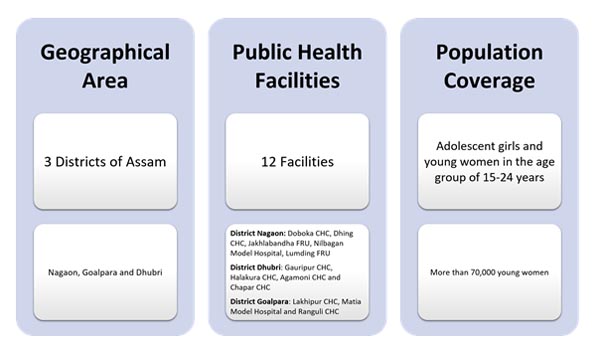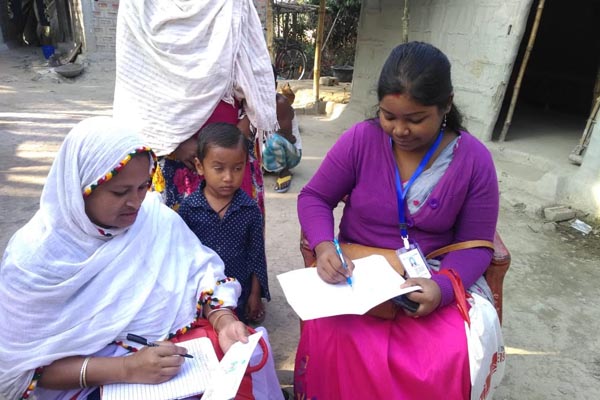Overview
Globally, 25 million women and girls undergo unsafe abortions annually. Every day, 13 women die in India due to unsafe abortion-related complications. These deaths source from lack of trained abortion providers, unawareness about the legal aspects, lack of safe abortion services and the social stigma surrounding abortion and the sexual reproductive rights of women.
About the Programme
With the objective of making adolescent girls and young women aware of their sexual reproductive health and rights, VHAI with support from IPAS Development Foundation initiated the project “Community Mobilization for Improved Access to Sexual and Reproductive Health and Rights (SRHR) including Safe Abortion Services” in November 2018 in Assam. Targeting the youth, especially adolescent girls and young women in the age group of 15-24 years, the project is being implemented in the catchment areas of 12 Public Health Facilities in three districts of Assam.

The programme sets forth to strengthen knowledge, attitude and practices among young women on SRH services including safe abortion services. It also focuses on strengthening knowledge and practices of local health providers (doctors) and health intermediaries from public health facilities to improve access to SRH services for young women, particularly keeping in view with the Ministry of Health and Family Welfare, Government of India’s flagship programme for adolescent and young girls – the Rashtriya Kishor Swasthya Karyakram(RKSK).
| District | Public Health Facilities | *Youth population to be covered. |
| 3 districts (Nagaon, Goalpara and Dhubri) |
12 facilities (Nagaon District: Doboka CHC, Dhing CHC, Jakhlabandha FRU, Nilbagan Model Hospital, Lumding FRU. Dhubri District: Gauripur CHC, Halakura CHC, Agamoni CHC and Chapar CHC. Goalpara District: Lakhipur CHC, Matia Model Hospital and Ranguli CHC ) |
6000 females in the catchment area of each facility |
Young Women in the age group 15-24 years, married and unmarried.
- Young men
- Selected CAC & CCC trained government health providers
- Health Intermediaries (AWW, ASHA, ANM) and Community Opinion Leaders
- Family and Friends
The broad strategy includes following:
- Partnering with youth to sensitize young women in the community
- Use of existing IEC available with RKSK and Family Planning division of the state. Need based adaptation and designing of required communication material and tools to suit local needs
- Intensive community outreach by trained youths (Youth Leaders) with young women in the catchment area of selected public health facilities
- Creating youth friendly SRH services in the selected public health facilities and strengthening referral linkages to these facilities. Strengthen ARSH clinics and engage with the counsellor to ensure youth friendly services.
Key Activities
Youth Leaders (YLs) are responsible for sensitizing young women’s groups (15-24 years) on various SRHR issues including safe abortion services. They work within a defined catchment area, around the selected health facilities. They also help in linking the women to the nearby health facilities for health checkup or treatment as and when required. Hence, it was necessary that the Youth Leaders were regularly trained to provide the adolescent girls and young women accurate information with patience and sensitivity.
In order to reach out to adolescent girls and young women, it was crucial to identify their population. Hence, household mapping was conducted. A total of 73,503 women were covered in 667 villages. These included 41,897 women between the age of 15 to 19 years and 31,606 women of 20 to 24 years age. The mapping exercise was done with the help of health intermediaries such as ASHAs at village level.
After the mapping exercise, the Youth Leaders along with the Coordinators interacted with the identified girls and women through one-to-one and group meetings. During such interactions, the team made use of relatable games & group activities to create a rapport after which the girls gradually started sharing their SRHR issues and concerns with the team. The project has reached out to more than 70,000 targeted young women through group and one-to-one meetings.
Young women and adolescent girls who wanted to seek professional help were referred to the designated Health Facility wherein their issues were addressed and treated. Periodic follow-up of the referred patients were done by the Youth Leaders. More than 10,000 young women were referred to the health facilities for SRHR issues. The programme helped in establishing a simple and clear referral mechanism between the community youth and designated health facilities which ensured that the youth were able to access SRHR services freely and without any hesitation.
In order to encourage the young girls and women to share their SRHR problems freely beyond the social taboos, stakeholders such as Self-help group members, PRI Members, ward members, teachers, religious, opinion leaders and youth groups were actively involved. These groups & committees were sensitized on the SRHR issues faced by the young women and adolescent girls. The Youth Leaders actively participated in Gram Sabhas (Village meetings) organized by the Panchayat members- signaling that the project had gained the acceptance even in remote communities.
Recent Activities
- Swasthya Mela: Swasthya Mela was organised in Dhubri District in December, 2019 to provide a common interactive platform for all the stakeholders especially Youth leaders to share their experiences and learnings in the area of SRHR in the context of Government’s RKSK programme. The programme was attended by various Government officials, 450 adolescents from 25 schools and nearby villages.
- Observation of World AIDS Day: The World AIDS Day 2019 themed “Communities Make the Difference” was observed in collaboration with the Red Ribbon Alliance in five facilities in Jakhalabandha, Lumding, Lakhipur, Doboka and Nilbagan. The programmes were attended by adolescents, Community Health Intermediaries (CHIs), teachers, doctors, the community and Border Security Force (BSF) The event was covered extensively through media.

